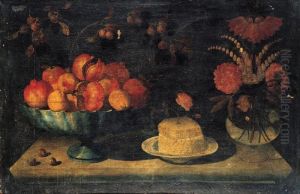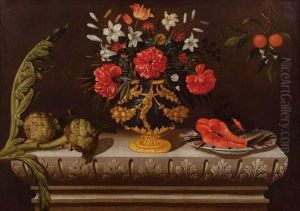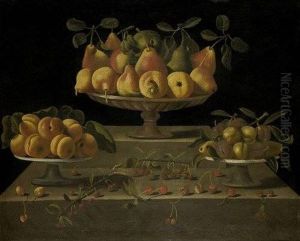Pseudo Hiepes Paintings
Pseudo Hiepes, also known as Tomás Hiepes or Tomás Yepes, was a Spanish painter who is best known for his still life works. Born in 1610 in Valencia, Spain, Hiepes played a significant role in the development of still life painting in the Spanish Baroque period. His work is characterized by the meticulous depiction of everyday objects, such as fruits, flowers, and kitchen utensils, often arranged on a table with a sense of order and harmony that is typical of the bodegón style, a genre of still life painting that flourished in Spain during the 17th century.
Hiepes received his initial training in Valencia, a city with a vibrant artistic community at the time. His work was influenced by the prevailing tenebrist style, characterized by dramatic contrasts of light and shadow, which was popularized by Italian artist Caravaggio and widely adopted by Spanish painters. However, Hiepes's approach to still life was more reflective of the brighter and detailed Valencian style.
Throughout his career, Hiepes produced a significant number of paintings, many of which were commissioned by religious institutions and members of the Valencian nobility and bourgeoisie. His paintings were appreciated for their realism and the sense of tranquility they conveyed. Hiepes's ability to depict textures and materials with great fidelity made his work popular among his contemporaries.
Hiepes's contribution to the still life genre was notable for the introduction of floral arrangements and the inclusion of elements that reflected Spanish culture, such as ceramics from Manises and Talavera de la Reina. His compositions often included a variety of objects, showcasing his skill in rendering different surfaces and materials, from the translucency of glass to the sheen of metallic vessels.
Tomás Hiepes died in 1674 in Valencia. Although he may not be as widely recognized as some of his European counterparts, his work remains a significant part of the Spanish Baroque canon and continues to be studied and appreciated for its beauty and technical proficiency. His paintings can be found in various museums and art collections, both within Spain and internationally, contributing to the understanding and appreciation of 17th-century Spanish still life painting.


